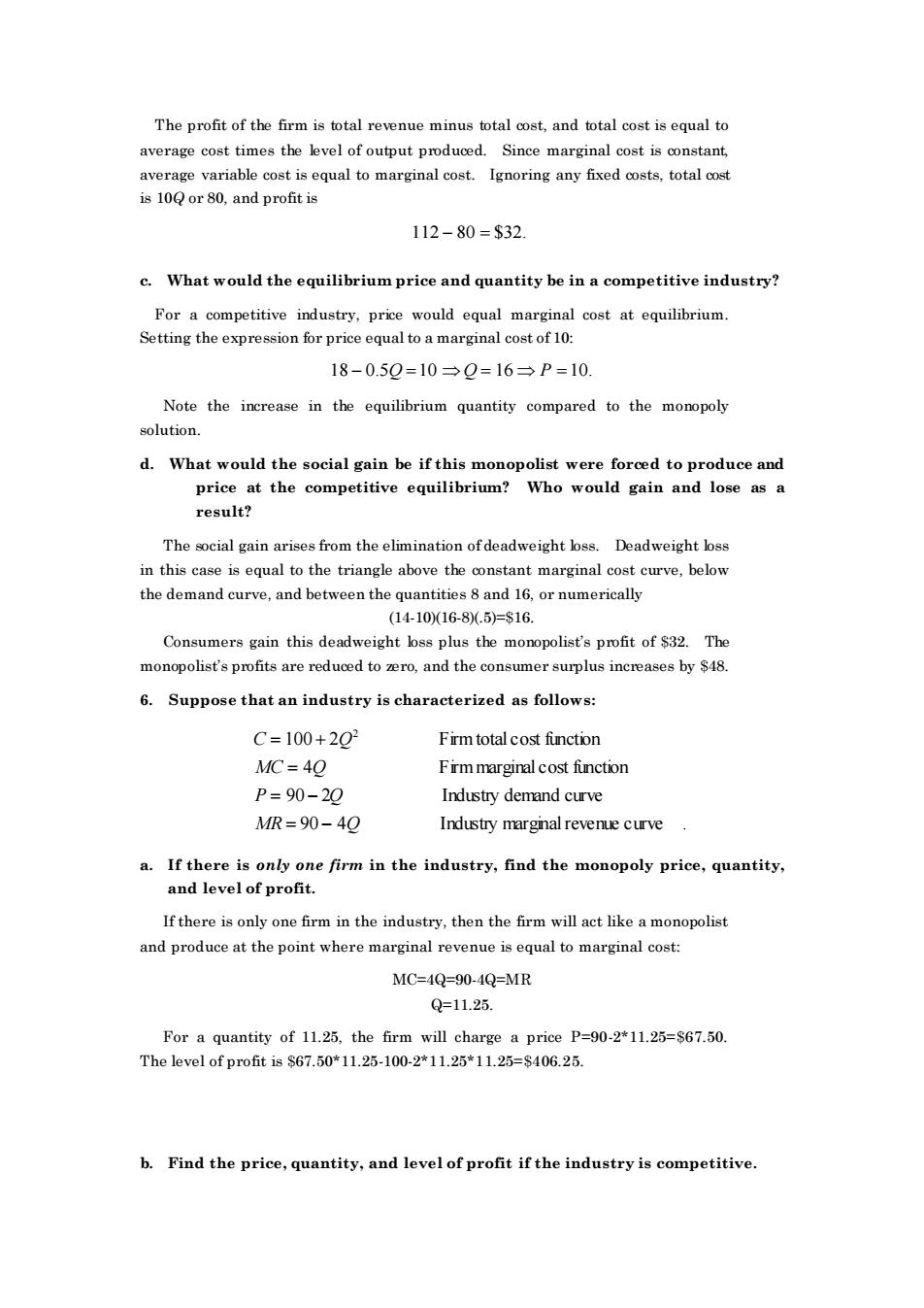正在加载图片...

The profit of the firm is total revenue minus total cost,and total cost is equal to average cost times the kvel of ouput produed.Since marginal cos isconstan average variable cost is equal to marginal cost.Ignoring any fixed costs,total cost is 100 or 80,and profit is 112-80=$32 c.What would the equilibrium price and quantity be in a competitive industry? Setting the expre for price equal toamarginal cot of10 18-0.50=10→2=16→P=10. Note the increase in the equilibrium quantity compared to the monopoly solution. d.What would the social gain be if this monopolist were forced to produce and price at the competitive equilibrium?Who would gain and lose as a result? The social gain arises from the elimination ofdeadweight loss.Deadweight lss in this case is equal to the triangle above the onstant marginal cos eurve,below the demand curve.and between the quanti es8 and 16.or numerically (14-10)(16-8M.5=$16. Consumers gain this deadweight lss plus the monopolist's profit of $32.The monopolist's profits are reduced toro,and the consumer surplus increases by $48. 6.Suppose that an industry is characterized as follows: C=100+2Q Firmtotal cost finction MC=40 Frm marginal cost function P=90-20 Industry demand curve MR=90-4Q a.If there is only one firm in the industry,find the monopoly price,quantity, and level of profit. If there is only one firm in the industry,then the firm will act like a monopolist and produce at the point where marginal revenue is equal to marginal cost. MC=4Q=90-4Q=MR Q=11.25 For a quantity of 11.25.the firm will charge a price P=90-2*11.25=67.50 The1 evel of67.50*11.25-10-2*11.25*11.25=s406.25. b.Find the price,quantity,and level of profit if the industry is competitive.The profit of the firm is total revenue minus total cost, and total cost is equal to average cost times the level of output produced. Since marginal cost is constant, average variable cost is equal to marginal cost. Ignoring any fixed costs, total cost is 10Q or 80, and profit is 112 − 80 = $32. c. What would the equilibrium price and quantity be in a competitive industry? For a competitive industry, price would equal marginal cost at equilibrium. Setting the expression for price equal to a marginal cost of 10: 18 − 0.5Q =10 Q = 16 P =10. Note the increase in the equilibrium quantity compared to the monopoly solution. d. What would the social gain be if this monopolist were forced to produce and price at the competitive equilibrium? Who would gain and lose as a result? The social gain arises from the elimination of deadweight loss. Deadweight loss in this case is equal to the triangle above the constant marginal cost curve, below the demand curve, and between the quantities 8 and 16, or numerically (14-10)(16-8)(.5)=$16. Consumers gain this deadweight loss plus the monopolist’s profit of $32. The monopolist’s profits are reduced to zero, and the consumer surplus increases by $48. 6. Suppose that an industry is characterized as follows: C = 100 + 2Q 2 Firm total cost function MC = 4Q Firm marginal cost function P = 90 − 2Q Industry demand curve MR = 90 − 4Q Industry marginal revenue curve . a. If there is only one firm in the industry, find the monopoly price, quantity, and level of profit. If there is only one firm in the industry, then the firm will act like a monopolist and produce at the point where marginal revenue is equal to marginal cost: MC=4Q=90-4Q=MR Q=11.25. For a quantity of 11.25, the firm will charge a price P=90-2*11.25=$67.50. The level of profit is $67.50*11.25-100-2*11.25*11.25=$406.25. b. Find the price, quantity, and level of profit if the industry is competitive